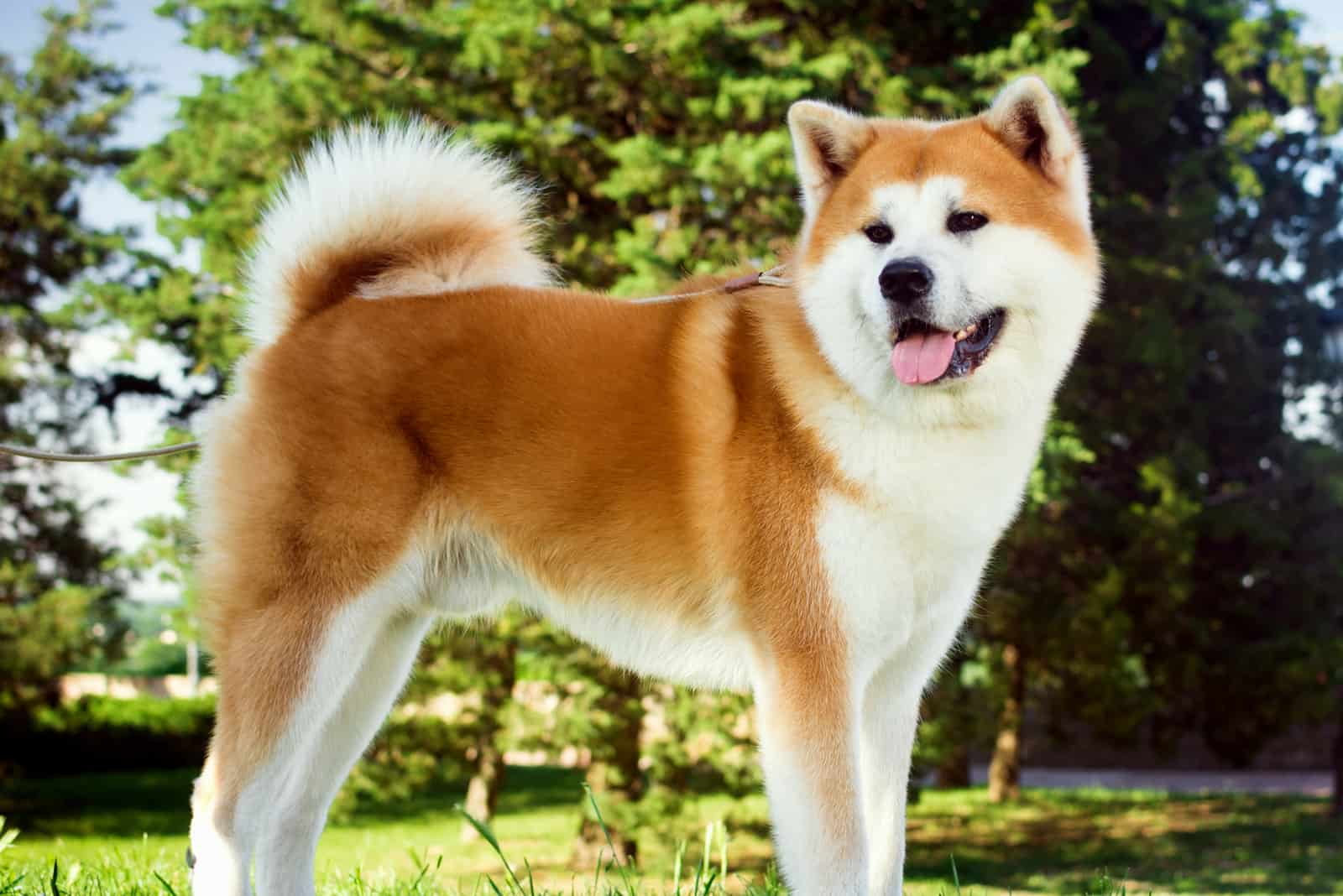Akitas are an exotic dog breed that can make fantastic family pets. However, there are some significant differences when it comes to male vs. female Akita. Once you understand these differences, you can better decide which dog is best suited to your household.
When you want to get an Akita puppy, one of the first things you should look at is whether you should get a male or female dog. This isn’t a ‘gender fight’ – in fact, there are plenty of reasons why someone would prefer one over the other.
So, male vs. female Akita – which one is better?
While there isn’t a straightforward answer, there are a few ways to determine which is better for you. For example, if you want a pup who’s loyal, easy to train, and good with kids, then a female Akita might be a better choice.
However, if you want a dog that is more social overall, playful, and ready to bond with each and every family member, then a male Akita might be more suitable.
Even this explanation is very simplified. To understand the subtle differences between male and female Akitas, you need to look at things in more detail. We’ll explain all the reasons why it’s important to choose the gender carefully.
Akita Inu Male Vs. Female
Before we get any further into detail, it’s important you understand some basic differences when it comes to male vs. female Akitas. This table can help you with some general information:
[table id=56 /]
Male Vs. Female Akita – Physical Differences
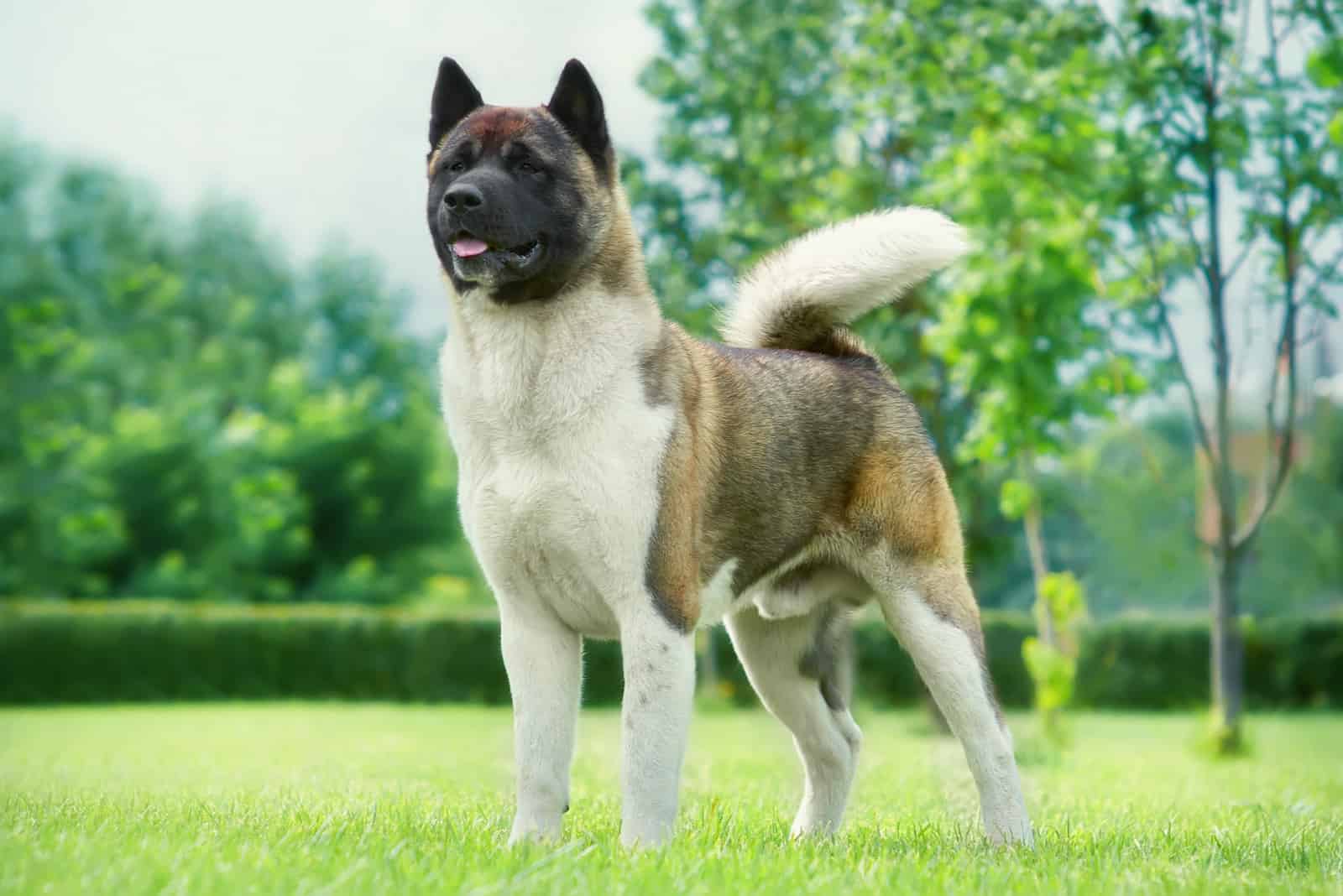
The first difference you may notice is that there are physical differences between male and female Akitas. Still, to understand this, you need to know a little bit about this dog breed.
The first and most important is that there are two types of this dog breed – the Japanese and the American Akita.
According to the American Kennel Club (AKC), Akitas – also known as Akita Inus – are dogs that originate from Japan. They have double coats and are famous for their courage, loyalty, and dignity. They are a symbol of happiness, longevity, and good health, and they are considered to be family protectors.
Proof of the Akita’s loyalty can be seen in Hachiko, a Japanese dog who waited years at a train station for his late owner to return home from a trip during which he passed away.
In fact, Hachiko inspired famous writer and dog lover Helen Keller to bring the first Akita dog from Japan to the United States. From there, the breed became widespread.
They can come in several coat colors, such as brown, white, black, white and brown, brindle, and even tricolor.
Akitas are fairly clean dogs that don’t have much ‘doggy odor,’ especially compared to other dog breeds with the same amount of fur.
They are known for their large heads and long, fluffy curled tails. They are large dogs that are known to be somewhat reserved towards strangers.
But, what physical differences are there between a male and a female Akita dog?
Male Akita
Male and female Akitas look very similar to one another, but some differences exist. This is especially clear when you look at these dogs in person.
Male Akitas tend to have a height of around 26 to 28 inches. This makes them about two inches taller than females. In fact, they are considered to be large dogs overall. They weigh around 100–130 lbs, which is quite a lot. Learn more in our Akita growth chart.
They have a sturdier appearance and a larger head than females. Their bodies also have more muscles, so they are bulkier.
Female Akita
There aren’t many differences when it comes to the coat or overall appearance between males and females. However, females are noticeably smaller. They are rarely taller than 26 inches and almost never weigh more than 100 lbs.
While this may not sound like a lot, if you were to see two Akitas in person, you’d clearly be able to differentiate the genders.
At the same time, females are slimmer, as they have less muscle mass than males. You might even think they look more elegant.
What Is The Difference Between American And Japanese Akita?
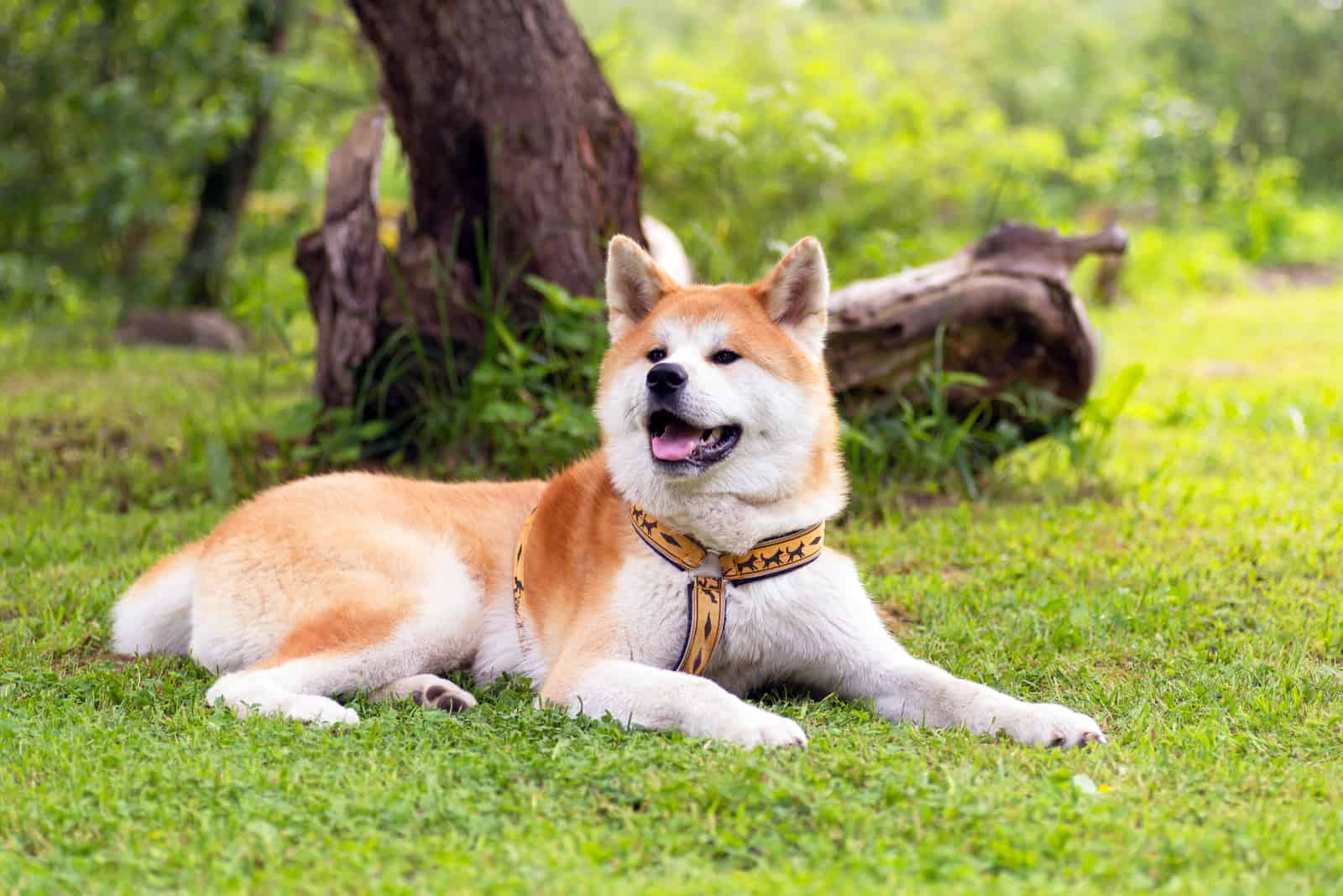
As we’ve mentioned, Helen Keller is the woman credited for bringing the Akita breed to the US. During that time, the breed began to diverge.
American service members who chose to continue bringing Akita to the US tried to pick more bear-like dogs. These dogs almost resembled German Shepherds in their build.
On the other hand, Japanese breeders fancied the smaller, fox-like type of dog, and they focused on restoring the breed to their ‘Natural Monument’ status.
This diversification created some differences between these two Akita types. Pretty soon, they were considered different breeds.
Overall, American Akitas tend to be larger, bulkier, and more intimidating than Japanese ones. However, there are a few other differences between them.
For example, American Akitas are acceptable in all colors, while their Japanese counterparts are accepted in white, red, or brindle. Also, American dogs can have black masks, while this isn’t in the breed standard for Japanese Akitas.
The Japanese Akita breed has a head that resembles dogs such as Spitz or even Samoyed, while American Akitas are more bear-like.
All of this led to the AKC recognizing the American Akita breed in 1955, but it wasn’t until 1972 that the club switched them from the Miscellaneous class to the Working Dog class. This means that the Akita breed is fairly new in the US.
Another thing that increased the bloodline differences is when the AKC cut off registration to all dogs imported from Japan in 1974. This ban continued until 1992, when the AKC approved the Japan Kennel Club, which was somewhat unknown in the West.
The American Akita Male Vs. Female
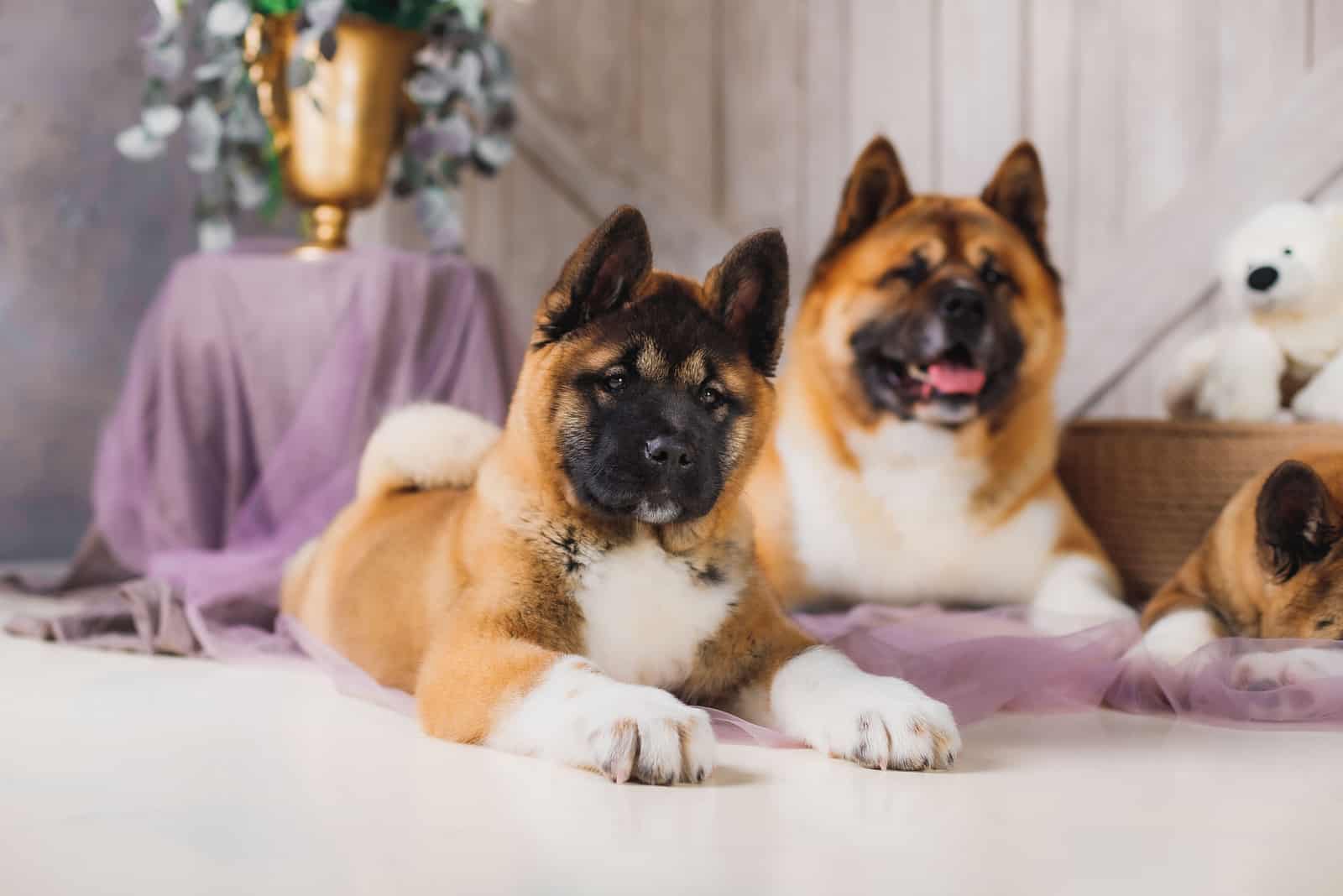
Despite them being known as a separate breed, the differences between male and female American Akitas are the same as the differences between Japanese Akita genders.
Males are somewhat larger and broader, with muscular bodies. On the other hand, females are a bit smaller, more elegant, and slim.
When it comes to temperament and other differences that we’ll mention later on, everything we say applies to both Akita types.
Akita Male Vs. Female Temperament

What concerns most Akita owners is whether there is a difference in temperament between male and female Akitas. You might not be pleased to hear that there is a significant difference in the way males and females behave.
Male Akitas
Male Akita puppies are as friendly as can be. They’re social and playful, and they seem to love everyone. However, as they start growing, their aggression begins to show.
The Akita breed is known for being loyal and devoted dogs. This is something all Akita owners have experienced. However, adult males can be somewhat tough and bossy.
Male Akitas demand to be alpha dogs. This makes them quite aggressive towards other dogs, especially if you haven’t socialized them in time. Fortunately, this can be reduced if you neuter your dog, but more on that later on.
Both genders aren’t really tolerant of strangers. However, when in public, males can be somewhat easier to control. This is because they love to make you happy, and if you tell them to stay calm, they’ll do so.
Most of these behavioral differences are the result of testosterone. This hormone is excellent for giving these dogs the muscles and the temperament they need to fight off intruders. However, it can also negatively affect their temperament.
Also, these dogs are well-known for being clean and quiet – however, males can be somewhat messy.
At the same time, male Akitas tend to be somewhat rigid and stubborn. They’ll require straightforward directions and commands from their owners. Otherwise, their thoughts might wander off, and they might not be as willing to do what they’re told.
Males are more likely to bond with all family members, and they tend to be protective. They are loyal guardians and protectors, making them excellent family pets.
Female Akitas
Female Akitas tend to be less playful and more serious than their male counterparts. They aren’t as aggressive as males, but they still don’t tolerate other females, as well as most other pets.
Females also won’t tolerate strangers in public. Depending on the situation, this can be both good and bad. They tend to be less sociable and will rarely want to make friends with new people, visitors, and unknown dogs.
Just like males, they will be very friendly as puppies, but their tolerance will wane as they grow older. Same-sex aggression is a huge problem with Akita females. Proper socialization and training are key to helping them behave in public.
Females also make amazing and loyal family dogs. However, unlike males, they prefer to have their own space and won’t follow you from room to room. Still, they can learn to be close with every family member.
Also, females aren’t as stubborn as males. They will understand your emotions and behave in the most appropriate way. This makes them somewhat easier to train and housebreak.
Are Male Or Female Akitas More Aggressive?
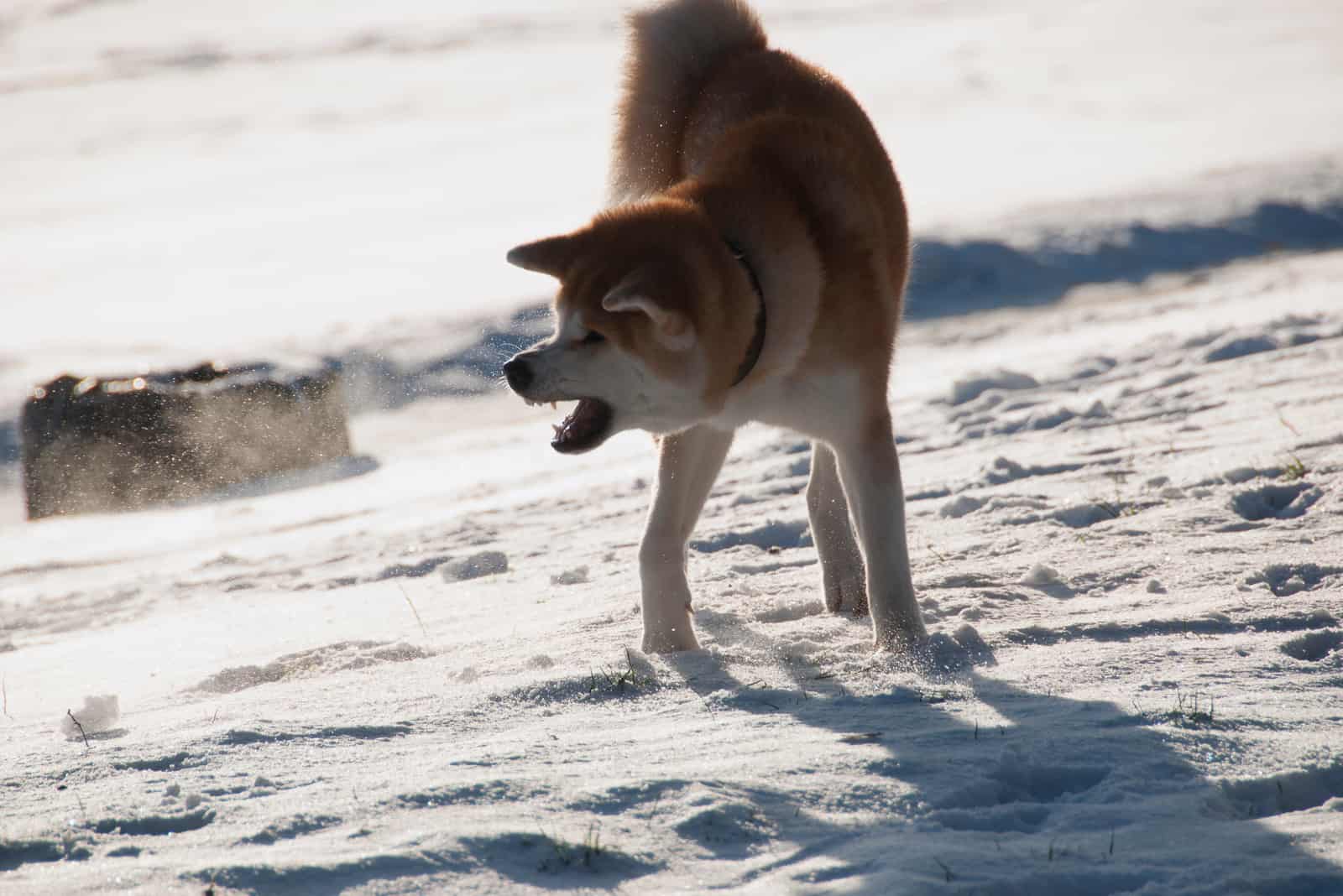
After reading these differences in temperament, you might struggle to decide which gender is more aggressive. Understanding male vs. female temperament is the key to this.
Of course, all dogs are individuals, and most problems can be dealt with proper training. However, both genders of Akita dogs tend to have a bit of an aggression problem, especially if you haven’t socialized them.
Still, unlike with most other dog breeds, male Akitas tend to be much more aggressive than females. They demand to be in charge, and they’ll do anything they can to stay the alpha dog.
At the same time, they are significantly larger than females. This makes them challenging to control, especially when testosterone kicks in.
Females can also be aggressive, especially towards other females. However, they are easier to control, and they aren’t as dominant as males.
Despite this, if you train your dogs appropriately, they can learn how to tolerate other animals and people. However, most will never become extremely friendly and easily-excited dogs that will love meeting passersby.
Spaying and neutering can also help dogs calm down a bit, especially males, as this will limit their hormone levels.
Do Akitas Get Along With Other Dogs?
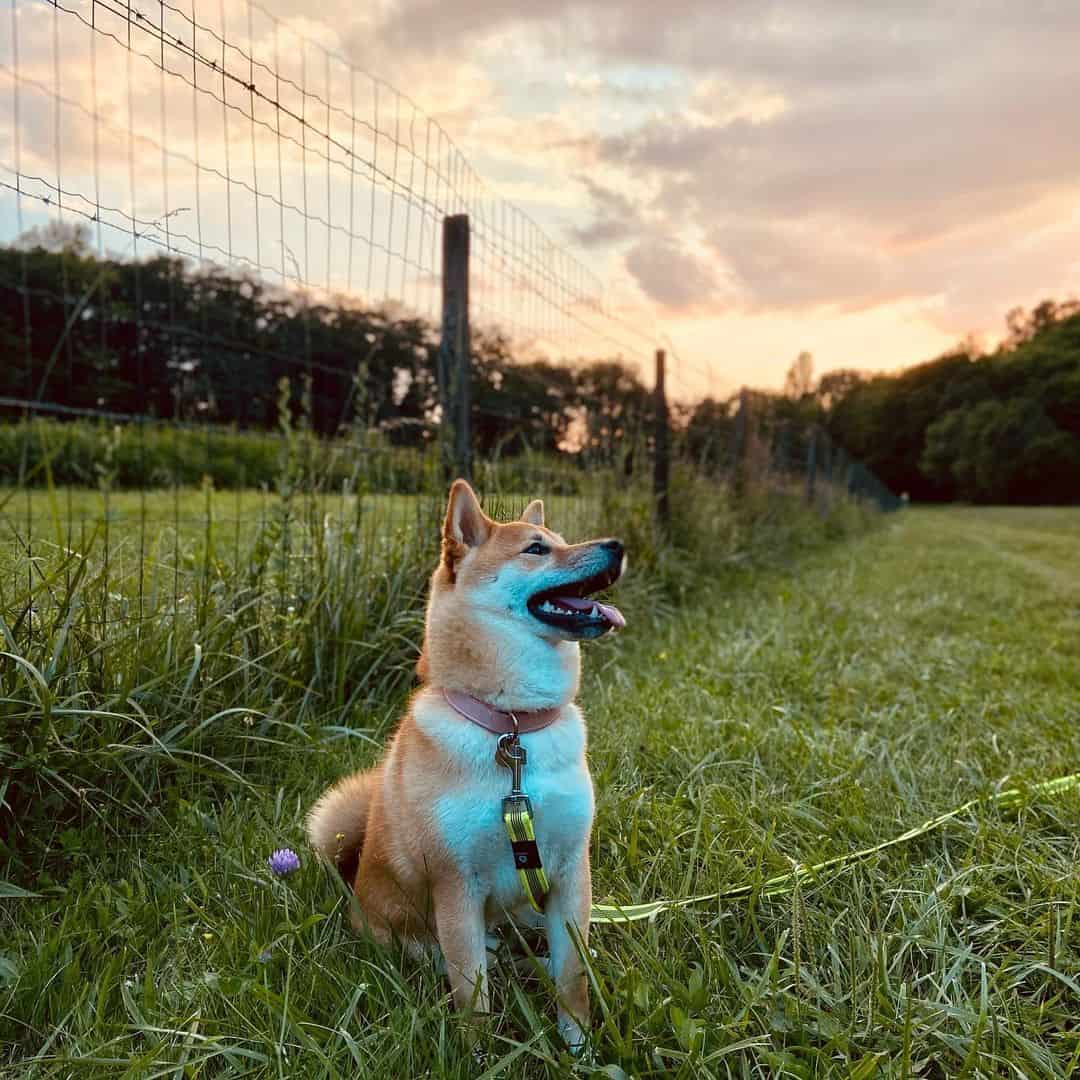
Photo from: @naya.maiko
What worries most aspiring Akita owners is whether their new puppy will do well with other dogs.
The truth is, both male and female Akitas will do best being the only pet in the household. They can be very aggressive towards other dogs, especially dogs of the same gender. Unaltered males will be extremely aggressive towards other males, and fights are likely to happen.
It isn’t impossible for Akitas to get along with other pets and dogs in the household. However, this will require much more training than with most other dog breeds. Even socialization might not be enough for some dogs, and they’ll remain intolerant of other pets.
Of course, all dogs are individuals. Even some Akitas can be very friendly toward other pets. However, most members of the breed will be too aggressive for a household with several dogs.
The reason behind this behavior lies in their genetics. Akitas were bred to be bear hunters and guard dogs, and they were also used in dogfighting. All of this means they have seriously aggressive genetics. Keeping in mind that they are a strong and large breed, they could easily kill another dog.
No matter the amount of training and socialization, many dog owners reported their Akitas remaining aggressive to the point they won’t let them be friends with other canines. This is something that is important to keep in mind when you decide to adopt an Akita puppy.
Getting a dog of the opposite gender might help a bit with this aggression. Some males can do well with female canines and vice versa. Just make sure they are spayed or neutered. Otherwise, you might end up dealing with unwanted puppies.
Male Akitas
Males are more dominant than females, meaning they are more likely to fight other dogs in an attempt to assert dominance. This is especially the case if another dog in the household is also male.
Fortunately, if you neuter your male Akita, this will lower the chances of him attacking another male dog. However, if you don’t do this, constant fights are to be expected. You should focus on socializing them while they are very young, as this can create a strong bond between two dogs.
Also, male Akitas tend to be territorial. If an unknown male dog enters your property, they will go after them. If the new dog initiates a fight, they won’t hesitate to strike back.
Female Akitas
Female Akitas tend to be cautious with any new dog you introduce them to. However, they are less likely to involve themselves in a confrontation, as they don’t have to be dominant all the time.
Still, having your female Akita play outside with other dogs can be somewhat tricky. Same-sex aggression is very common between females – maybe even more so than with males. Also, this cannot always be fixed by spaying your dog.
The biggest difference here is that males will usually stop fighting once they determine which one is the alpha dog. However, females will keep on fighting until one side is severely injured, or even worse.
If, for any reason, you plan on having two females in the same household, make sure there is at least a two-year age gap between them. This will increase the chances of them getting along. Still, we would recommend that you don’t have two females in the same house.
Male Vs. Female Akita – Do They Get Along With Other Pets?
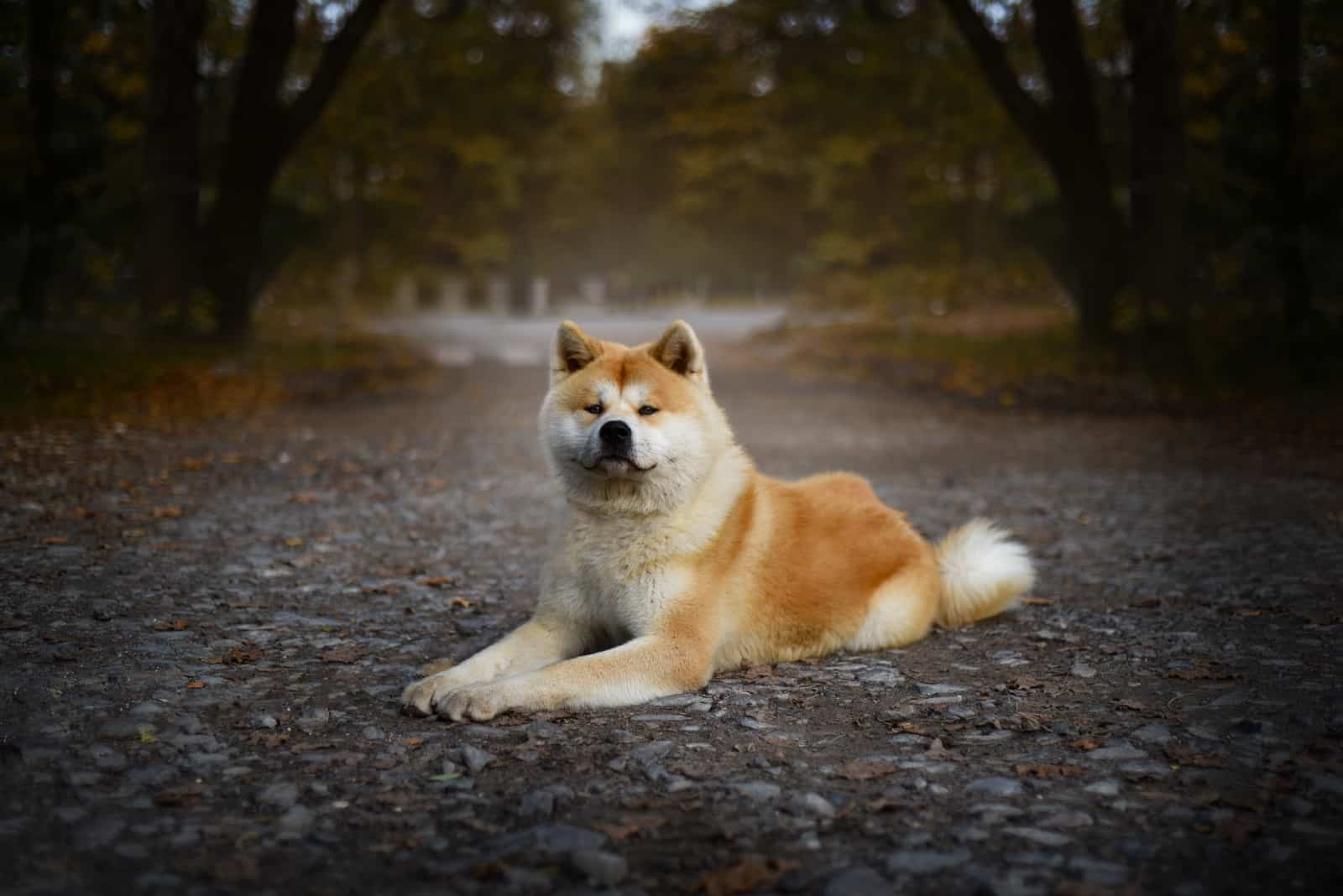
If you have another pet, whether that be a cat or a gerbil, you might wonder whether they can befriend your Akita.
While the chances are slim, here are some differences you should know.
Male Akitas
Male Akitas have to be introduced to new pets from a very young age. Otherwise, they can attack them. Smaller pets can even be seen as a threat to their territory or even prey.
Getting a small animal such as a Shiba Inu or a cat might be a dangerous decision if you already have an adult male Akita. These dogs can be very aggressive, and when they attack, they can attack to kill.
You may be able to train some male Akitas into befriending pre-existing pets. However, you have to monitor them closely until you can be 100% certain they won’t attack and hurt anyone.
Unfortunately, this is rarely the case if you bring a new pet into a household with a male Akita.
Female Akitas
Most of the time, female Akitas are less territorial and less dominant than males. This also makes them less aggressive towards other dogs. However, they, too, will rarely tolerate another pet’s presence.
If you’ve trained your Akita from a very young age, you might have a greater chance of her befriending other pets.
Keep in mind that two female dogs will rarely coexist in the same household, even if you spay them. Female Akitas are simply not dogs that love company.
Male Vs. Female Akita – Are They Good With Kids?
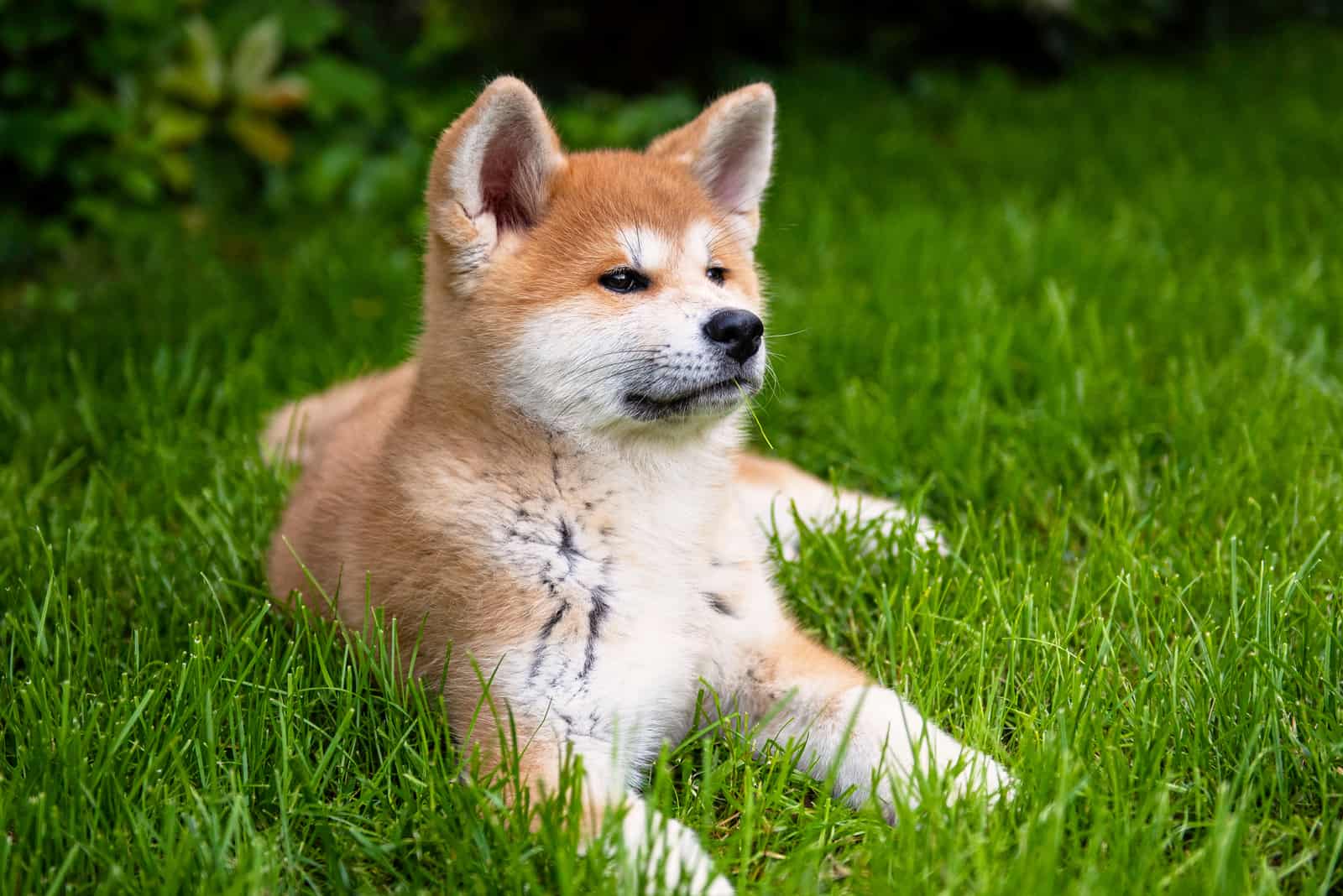
Another concern that might plague future Akita owners is how well these watchdogs get along with children.
Despite all the tales about Akita Inus being amazing babysitters while Japanese women worked in the fields, you do not want to leave your Akita with children unsupervised.
In short, the Akita breed is not the best for families with children. Despite them being loyal dogs, they are large, headstrong, and powerful. They can also be quite possessive over their food and toys, which is something not many kids can respect.
This breed is very temperamental. You can never be sure how Akitas will react in certain situations. All of this can make them somewhat dangerous. You should never leave your Akita Inu alone with your kids.
Still, there are some differences between genders here as well.
Male Akitas
Males tend to be somewhat more carefree than female dogs. One might say they’re even goofy! However, this can make them somewhat clumsy around kids. They are large and active, and they might knock over your child and endanger them.
A male Akita might also snap at a child if they encroach on his space. If he bites a kid, the injuries can be quite severe. Because of this, you should never assume that you can leave your kid with your large dog.
Fortunately, if you happen to have a less aggressive male, you can train them to tolerate kids. If you have the opportunity to teach them how to behave around kids while they are puppies, this can be very helpful.
When raised with kids, male Akitas can be very loyal, tolerant, and playful. They make devoted and affectionate family pets, and they’ll do all they can to protect them.
However, even a trained male Akita can be extremely food possessive, so don’t leave them alone with children.
Female Akitas
Females are usually less playful than males, making them calmer and more well-behaved. This also means they’re likely to be cautious around children.
Still, if you haven’t properly trained your dog, females can be just as dangerous as males. Because of this, you shouldn’t leave your Akitas alone with kids, no matter their gender.
One thing that makes females stand out is that they are likely to bond with one family member in particular. This can often be a child. If this happens, she will protect your kid at all costs and be very devoted to them.
Keep in mind that females need their own space. They won’t be as playful all the time, and they should always have a safe place where your kid cannot reach them. Otherwise, they might snap at your child.
Male Vs. Female Akita – Which One Is Suited For Family Living?

This is a question without an easy answer. Overall, both female and male dogs do well in certain family situations. Both are very loyal to their owners and other family members, and if they’re familiar with everyone, they will be very devoted pets.
It is up to you to decide which gender suits your lifestyle the best. However, there are some general guidelines that you might want to follow.
The most important thing you need to consider is the gender of your existing dog if you have any. Don’t get two dogs of the same gender, especially if one of those dogs is an Akita.
Male Akitas
Male Akitas tend to be a somewhat better choice if you and your family members love going out. They are active and playful, and they can fit that lifestyle pretty well.
Also, males won’t have a favorite human. They’ll bond with everyone equally, and they’ll love all their family members.
These dogs are protective of your property and will be alert at all times. If an intruder walks into your backyard or house, they’ll be courageous and won’t hesitate to defend you.
If you have a female dog, this is the main reason why you might want to get a male Akita. Just be mindful of the fact that even Akita males don’t really enjoy canine company, and they’ll behave better if they are the only dog in the household.
Female Akitas
Unlike males, female Akitas tend to bond to a specific family member. While this can be very beneficial and might suit people living alone, it can leave other household members feeling left out.
These dogs are more cautious around kids and won’t behave as aggressively around food or toys as males. Also, you can easily teach them most commands, so they can be more straightforward to control.
Females aren’t trusting of strangers, and they will be very loyal and protective of their owners in public spaces. They will do all they can to keep you safe – which can be somewhat of a nuisance, as they can snap at people who come close to you.
At the same time, females have a lower energy level than males. They won’t need as much activity, and they won’t require you to play with them all the time. If you’re someone who doesn’t go out as often, a female Akita might be a better choice.
Male Vs. Female Akita – Which One Is Easier To Train?
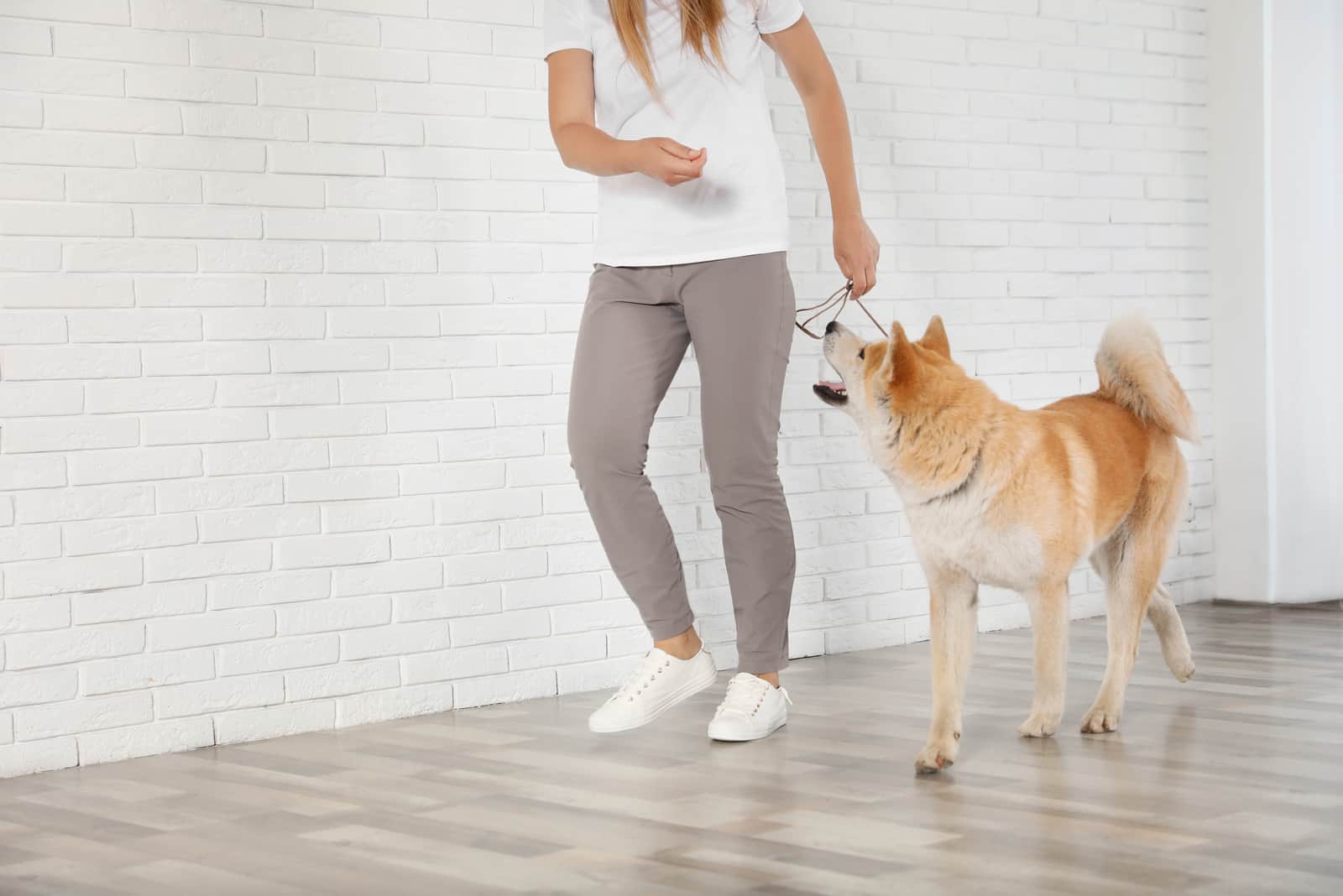
The Akita breed consists of very independent dogs. This makes it seem as if they are extremely difficult to train. Fortunately, these dogs are very clean, and this can help you with potty training.
These dogs are intelligent and loyal, but they can be quite stubborn, especially if they don’t feel like they’ll benefit from what you want them to do. This can make dog training somewhat challenging.
Using positive reinforcement and an especially large number of treats can be very helpful in keeping them motivated and willing to learn.
Of course, sometimes the help of a professional dog trainer will be necessary. This is especially the case if your Akita is no longer a puppy, but some corrections have to be made to their behavior.
Male Akitas
Male Akitas have a lot of energy that they need to channel. This is joined by high levels of endurance and strength. Your training plan has to be robust and dedicated. Keeping them focused on training can be really challenging.
Akita puppies can be very easily distracted, especially if they don’t feel like learning new commands at that moment. You might find it very difficult to train them while they are young – and when they are adults, they would’ve already developed behaviors you need to correct.
Because of all of this, males can be challenging to train and housebreak, especially during puppyhood.
Despite this, the best time for training your male Akita is when they are 7–9 weeks old. Although this might take you a lot of time, they’ll take these teachings with them to adulthood, and they’ll be more likely to obey.
Their lack of focus is the biggest issue when it comes to trainability. You won’t be able to walk them off-leash most of the time, as they can be too playful. Some males might even appear to be extremely social, which isn’t a common thing with this dog breed.
Males love being in control over everything. This might make them roam at will during training, as they’ll want to be in charge of the environment.
If possible, try training your Akita during somewhat colder weather, as this is when they feel most comfortable. This might make them listen to you more.
Another thing you can take advantage of is that males love pleasing their owners. They will do whatever they can to make their family members happy. This might make them want to do what you’re asking of them.
Female Akitas
Compared to males, females tend to be more serious, focused, and obedient overall. Because of this, they are much easier to train and housebreak. In fact, many females will potty train themselves, as they cannot imagine relieving themselves in the same place where they eat or sleep.
When your female Akita is young, you can find that training can be very straightforward. In fact, you may be very successful in teaching them all sorts of tricks and rules from an early age.
Still, female Akitas can become bored as quickly as males, although they won’t get distracted as easily. Also, they might not be as enthusiastic to complete everything you want them to do, as they don’t care that much about pleasing you.
These dogs can be very connected with their owner’s emotions. Light corrections might be all you need to make them behave the way you want them to. They might even respond to the lightest of corrections and praise.
Overall, if you’re looking for a dog that’s easy to train, or if you’re a first time dog owner, picking a female Akita might be a decent choice.
Male Vs. Female Akita – Which One Is The Better Guard Dog?

Akitas are natural watchdogs. They will do a great job keeping your house safe from intruders. You don’t have to teach them how to guard your home. If you are looking for a big guard dog, an Akita is a good choice since Akita dogs are protective dogs that will immediately fend off any intruders.
In fact, these powerful dogs can be as good guardians as Dobermans, and they are certainly better watchdogs than most Retrievers or Pitbulls.
On most occasions, the gender of an Akita doesn’t make a huge difference when it comes to their guarding abilities. Instead, it comes down to their environment and individual personality.
Still, a male or a female dog might be more suited for a specific situation. Here are some of them.
Male Akitas
Male Akitas are generally larger dogs with more muscle and strength than females. They also have more energy and stamina, and they can run around all day. This makes them somewhat better at defending your entire property.
They are also stronger, and their bite can be lethal – which might also be a problem if there is a human intruder.
Also, with male Akitas, you can be certain no unwanted dogs will enter your property or even your area, as they are motivated to keep everyone away from their home.
Female Akitas
Females are better when it comes to protecting an individual – most notably, her master. They are suspicious of strangers, and they won’t let anyone get near you unless you want them to.
They are more intelligent and more alert. Although not as strong as males, they are agile and fast, and they make excellent personal protection dogs.
Male Vs. Female Akita Cost
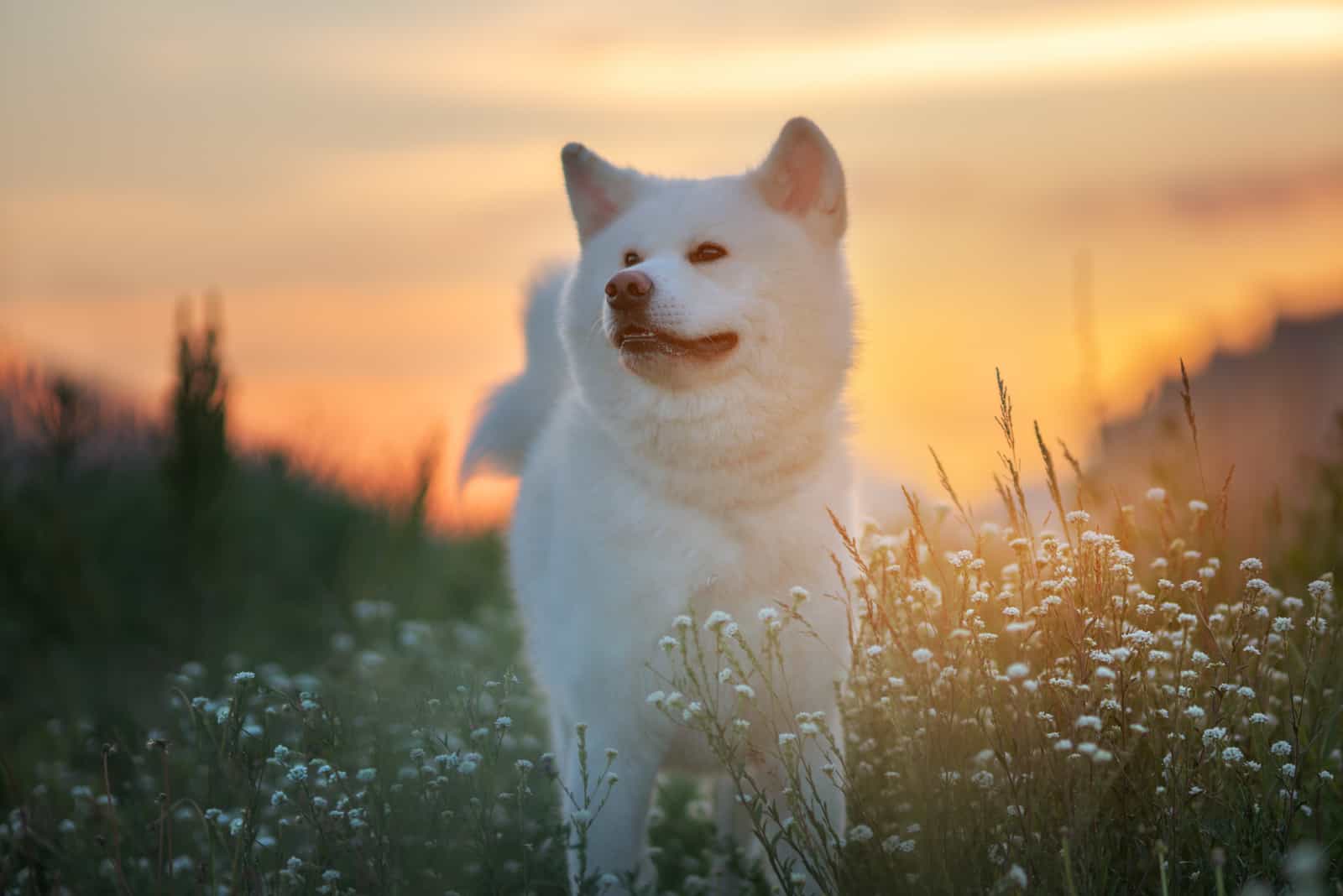
You can expect to pay anywhere between $600 and $2,000 for an Akita puppy in the US. This price depends on many things, such as the breeder’s reputation, the dog’s bloodline, and the area in which you live.
Usually, both genders will cost the same. However, sometimes you might find that females are a bit more expensive than males.
This is because females are more important for reproducing. They are the ones that birth puppies and a female Akita owner can start breeding dogs much easier than the owner of a male Akita.
Still, this price difference is minimal, if it even exists.
Male Vs. Female Akita Health
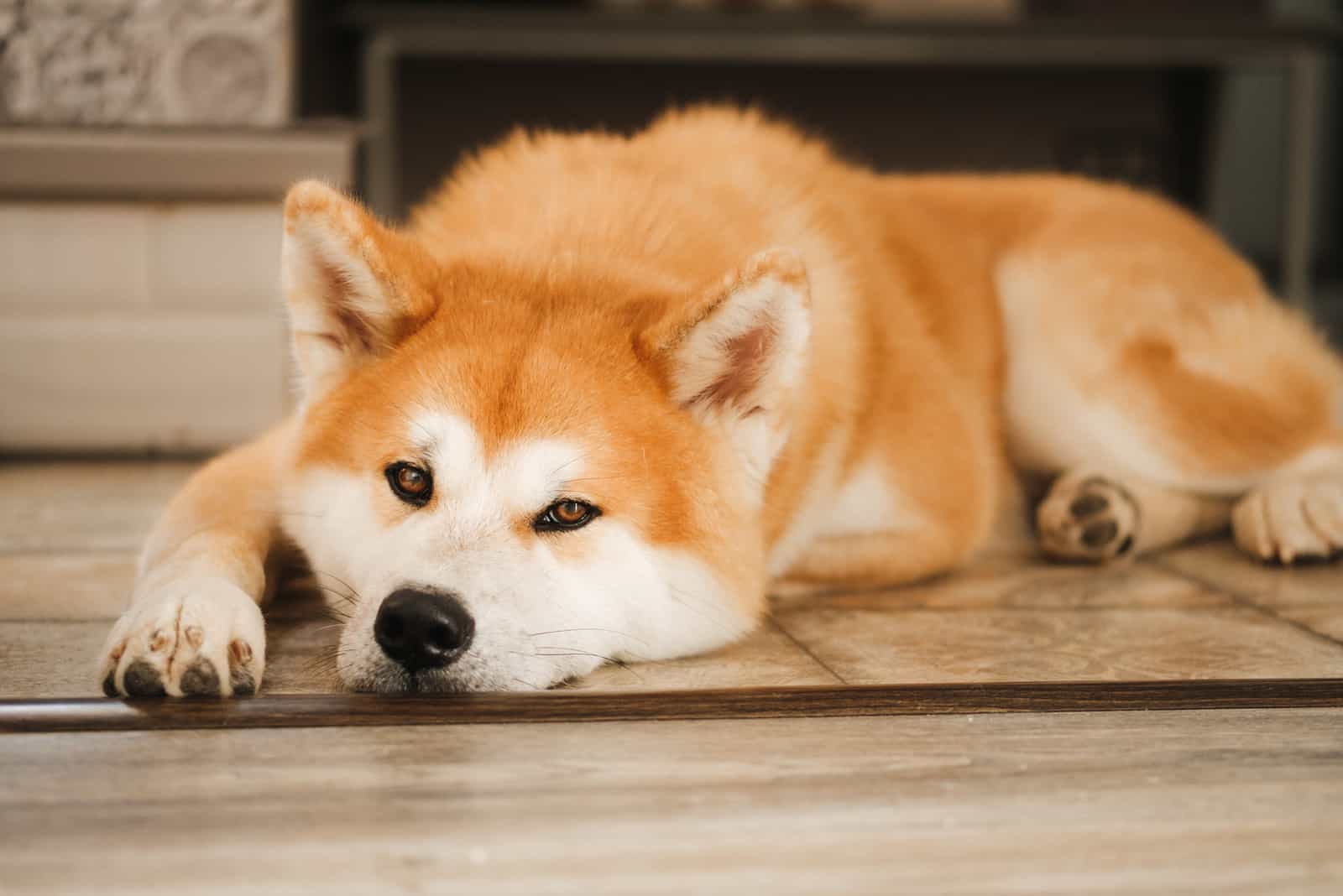
All dog breeds have the potential for developing some genetic health issues. One way you can make sure you have a healthy dog is to buy him from a reputable breeder.
Responsible breeders conduct all necessary health screenings and tests to ensure the dogs they breed are healthy and don’t carry any recessive genes for specific health conditions and illnesses.
Related: 11 Best Akita Breeders In The UK That You Need To Know About
Fortunately, the Akita Inu is a healthy breed. If you get your puppy from the right place, you don’t have much to worry about. They live 10–12 years on average, which is a decent lifespan for such a large breed.
Some of the conditions Akitas are prone to, no matter their gender, are:
• Hip dysplasia
• Progressive retinal atrophy (PRA)
• Von Willebrand disease
• Bloat
• Hypothyroidism
While most health conditions that affect one gender more than the other are connected with the dog’s reproductive organs, there is more to this.
Male Akitas
Compared to females, male Akitas are more prone to developing hip, joint, and bone health problems. This is likely because they weigh more than females.
Also, male dogs are more prone to obesity, especially if you’ve neutered them. This can be avoided if you feed them appropriate dog food and make sure they have plenty of exercise.
Males are prone to some health issues due to their weight and size. This includes bloat and hip dysplasia. Both of these conditions are common in deep-chested dogs that weigh a lot.
Male Akitas can also develop cancer of the prostate or testicles. Fortunately, this can be avoided by neutering them. Still, there is no proof that neutering will prolong a male dog’s lifespan.
With all this in mind, the lifespan of a male and a female dog will remain more or less the same.
Female Akitas
Females are smaller than males, and they weigh less. This also makes them less prone to hip, joint, and bone problems than males.
In fact, some research suggests that females might live a bit longer than males. This is because their body doesn’t put as much pressure on the heart as the bulky male’s body does. However, there still isn’t much proof of this.
Females are also less prone to gastric dilatation-volvulus, also known as bloat. This is also due to their lighter body and smaller chest. However, this doesn’t mean you shouldn’t conduct regular health tests on your Akita female.
Some female Akitas might also develop ovarian or uterine cancer. Because of this, it is recommended you spay your female dog unless you plan on breeding her. The changes in a dog’s hormone levels during heat might also influence the development of some health problems.
It’s worth noting that spaying is a more expensive and more complicated procedure than neutering. However, spayed females will, on average, live longer than unaltered ones, so the procedure is worth it.
Other than that, females are just as prone to most health concerns that males are. Make sure you get your puppy from a reputable dog breeder if you want to have a healthy dog that will stay with you for a long while.
Should I Get A Male Or Female Akita?
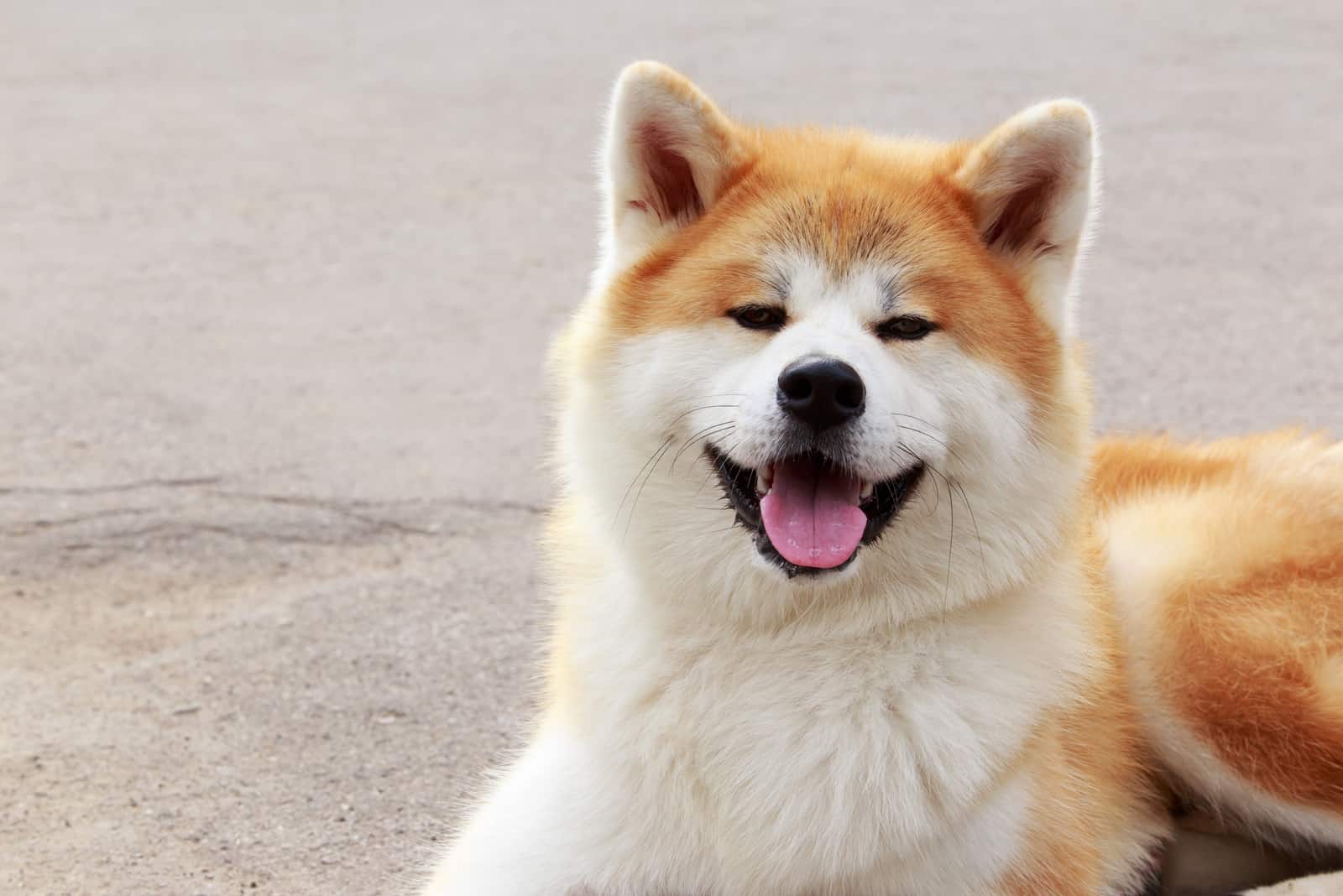
You may already have a brief idea of which is more suitable for you when it comes to male vs. female Akita Inu, but it’s worth summarizing everything to get a better picture.
While all Akitas make loyal and devoted pets, as well as excellent guardians, there are some things a specific gender does better.
Males are more aggressive than females, although they’ll rarely fight to kill. They aren’t good with other pets, especially small animals, as they’ll see them as either a threat or prey. However, they are more friendly towards other large dogs, especially females.
They might not be the best choice for kids, as they are protective of their food and toys, which might endanger an unsuspecting child. Still, their playful energy might correspond well with an active child, and they can become great playmates.
Male Akitas are also better guardians of your property, and they won’t allow any intruder – human or canine – to enter your house.
On the other hand, females are better personal guardians. They’ll bond with one person in the family, and they’ll become their devoted guardians.
Females aren’t as aggressive as males – unless there is another female dog nearby. If this happens, females can go for the kill, and breaking up a fight can be very difficult.
Female Akitas might also be a better choice for families with little kids, as long as your children understand that their pet needs some time for herself. They aren’t as food protective, and they might be more willing to share.
In the end, however, it all comes down to the gender of pets you already have inside your home. While Akitas aren’t overly friendly dogs, same-sex aggression is a common thing, and you should avoid having two dogs of the same gender inside your house.
If you plan on your Akita being an only pet, don’t worry too much. Most behavioral flaws of both genders can be fixed with good socialization and training, and all dogs can make amazing, loveable pets.
Read Next: The Long Haired Akita: A Myth Or Outcasts? Let’s Find Out


